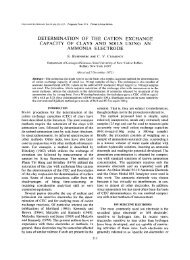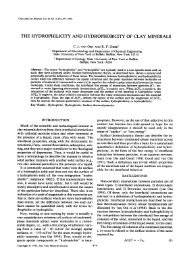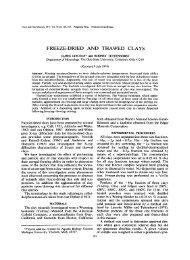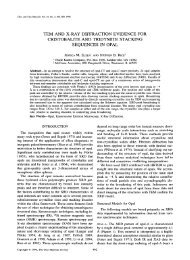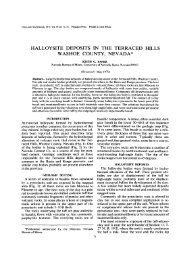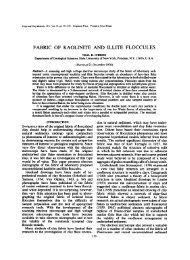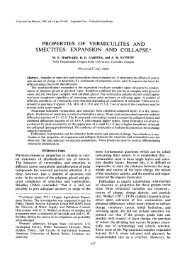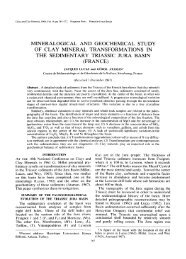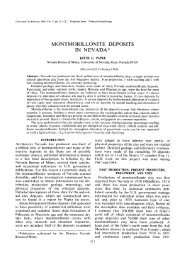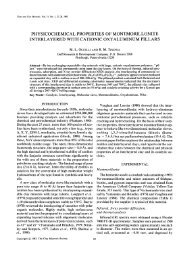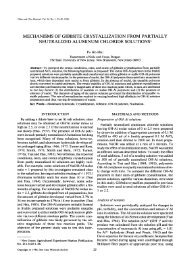formation of halloysite from feldspar: low temperature, artificial ...
formation of halloysite from feldspar: low temperature, artificial ...
formation of halloysite from feldspar: low temperature, artificial ...
Create successful ePaper yourself
Turn your PDF publications into a flip-book with our unique Google optimized e-Paper software.
18 WALTER E. PARHAM<br />
formed under natural weathering conditions <strong>from</strong><br />
the Hong Kong granite, taken <strong>from</strong> a suspension <strong>of</strong><br />
the clay fraction and mounted on a Formvarcovered<br />
electron microscope grid. This mineral<br />
was identified as <strong>halloysite</strong> - 4H20 by X-ray diffraction.<br />
Figure 7B similarly shows a bundle <strong>of</strong> tubes<br />
formed during the <strong>artificial</strong> weathering <strong>of</strong> K-<br />
<strong>feldspar</strong>. This alteration product has not been<br />
identified by X-ray because <strong>of</strong> the small amount<br />
present. Nevertheless, <strong>from</strong> the general form <strong>of</strong> the<br />
bundle <strong>of</strong> tubes the alteration product is inferred<br />
to be <strong>halloysite</strong> or its primitive form.<br />
The outer weathered surfaces <strong>of</strong> orthoclase<br />
crystals in syenite (sample DWB-I), exposed in a<br />
near vertical face along a road cut through fresh<br />
rock, show the same form <strong>of</strong> alteration products as<br />
the other K-<strong>feldspar</strong>s. The syenite rock surface<br />
was bare <strong>of</strong> soil and plant material where the<br />
<strong>feldspar</strong>s were sampled. The south-facing cut was<br />
exposed to the sun and subject to rainfall and<br />
surface rainwash. The obvious depth <strong>of</strong> weathering<br />
penetrated only 1-2 mm into the exposed <strong>feldspar</strong>s.<br />
Although the roadcut is slightly less than 5 yr old,<br />
the various forms <strong>of</strong> weathering products described<br />
thus far are already well developed here. It would<br />
be interesting to know the minimum time needed<br />
for <strong>formation</strong> <strong>of</strong> similar surface alteration products<br />
in the tropics and in <strong>temperature</strong> areas as well.<br />
Artificial weathering products formed on the<br />
plagioclase <strong>feldspar</strong> developed into much the same<br />
forms as those on K-<strong>feldspar</strong>. Long flame-shaped<br />
sheets formed on the plagioclase <strong>feldspar</strong> (Fig. 8),<br />
but no hol<strong>low</strong> tubes nor well defined rolled tubes<br />
were seen. Although this sample <strong>of</strong> plagioclase<br />
<strong>feldspar</strong> has an unweathered appearance in hand<br />
specimen, it was noted in replicas <strong>of</strong> cleavage<br />
surfaces prior to leaching that trace amounts <strong>of</strong><br />
flame-shaped sheets were already present and that<br />
scattered tiny bumps could be seen in small areas.<br />
After the leaching period, there was a pronounced<br />
increase in the amount <strong>of</strong> flame-shaped sheet<br />
material covering the <strong>feldspar</strong>'s surface. Moreover,<br />
there was now one additional product not<br />
present at the start. Scattered over the plagioclase<br />
<strong>feldspar</strong> surfaces were areas containing prominent<br />
flakes <strong>of</strong> regular geometric form (Fig. 9), the diameters<br />
<strong>of</strong> which range <strong>from</strong> 0.25 to 1.25/x. X-ray<br />
diffraction data shows the mineral to be most<br />
probably boehmite (Fable 5). An <strong>artificial</strong> weathering<br />
study on kaolinite by Pedro and Berrier (1966)<br />
using a Soxhlet apparatus, showed by X-ray<br />
diffraction that kaolinite was partially converted to<br />
boehmite and not gibbsite after prolonged leaching.<br />
Based on conditions <strong>of</strong> minimal <strong>temperature</strong> and<br />
pressure under which boehmite could form<br />
(Kennedy, 1959) and on the X-ray reflections <strong>from</strong><br />
the <strong>artificial</strong>ly weathered <strong>feldspar</strong> it would seem<br />
likely that the regularly shaped platy weathering<br />
Table 5. X-ray reflections for plagioclase <strong>feldspar</strong> (ANT0) before and after<br />
107 days <strong>of</strong> <strong>artificial</strong> weathering, and newly developed reflections <strong>of</strong><br />
boehmite<br />
Fresh <strong>feldspar</strong> Weathered <strong>feldspar</strong> Weathering product-boehmite<br />
hklandlest, lest. ,~ hklandlest.<br />
6-56 1]0 in w<br />
4-69 021 w w<br />
4-04 20]- m m<br />
3.92 111 w w<br />
3.77 130 m m<br />
3.65 131 m w<br />
3-47 l12w w<br />
3.38 ll2m m<br />
3.26 (?) m w<br />
3.20 040 s s<br />
3.17 002 s s<br />
3-14 220 s w(?)<br />
3.05 131 w w<br />
2-94 041 m w<br />
2.84 131 m w<br />
2.52 241, 1T2 m w<br />
2-39 310, 150 m<br />
2.23 244 rn w<br />
6.11 020rn<br />
2-35 041,130 w<br />
Estimated intensity (! est.) <strong>of</strong> X-ray reflections, s= strong, m=<br />
medium, w = weak.



